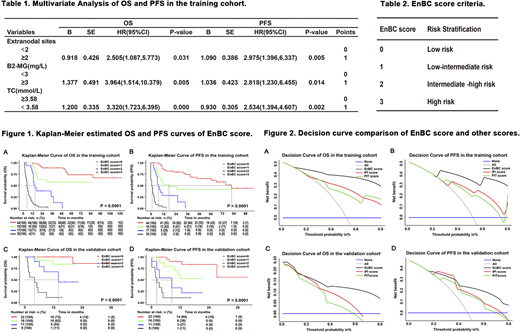Introduction:The current prognostic scoring systems for mature T and NK cell lymphomas are still insufficient in predicting the outcomes of patients. It is urgently needed to identify novel predictors and develop a more accurate risk stratification system. Lipid metabolism accounts for a significant proportion in the tumor energy metabolism and even occupies a dominant position in non-glycolysis-dependent tumors. Dyslipidemia has been confirmed to be related to inferior outcomes of patients with solid tumors and several hematological malignancies. Nevertheless, there has been none prognostic scoring system containing lipid metabolism-related indicator reported at present. Thus, we aimed to investigate the association between lipid metabolism level and clinical outcomes, and further develop a novel lipid-based prognostic model in patients with newly-diagnosed mature T and NK cell lymphomas.
Methods:The study was performed retrospectively in Shandong Provincial Hospital. The patients were divided to the training cohort (from January 2006 to December 2016) and the prospective validation cohort (from January 2017 to June 2020). The inclusion criteria contain: (1) pathologically confirmed; (2) newly diagnosed; (3) with complete clinical and follow-up data; (4) without previous malignancies. The basic data comparison of the two cohorts was performed by Studentttest or Mann-Whitney U test for continuous variables and the chi-square test or Fisher's exact test for categorical data. Univariate analysis and multivariate Cox regression analysis were performed to detect independent predictors and generate a novel prognostic staging system. The efficiency and accuracy of the new scoring system were assessed in two cohorts from different aspects, including time-dependent receiver operating characteristic curves, Brier score and decision curve analysis.
Results:We developed EnBC score from a retrospective 115-patient training cohort using a multivariate Cox regression model and tested it in a prospective 58-patient validation cohort. The score was calculated by the extranodal involved sites, β2-microglobulin and serum total cholesterol (Table 1). EnBC score divided patients into four risk grades, low risk (0 point), low-intermediate risk (1 point), intermediate-high risk (2 points), high risk (3 points) (Table 2). Kaplan-Meier curves proved that patients in four risk grades presented significantly distinct long-term prognoses (median OS, NA vs. NA vs. 14.0 vs. 4.0 months, P<0.0001; median PFS, 84.0 vs. 19.0 vs. 8.0 vs. 1.5 months, P<0.0001) (Figure 1). Therewith, we examined the efficiency and accuracy of EnBC score in the training and validation cohort, respectively. Its predictive discrimination capacity, as determined by the area under the time-dependent receiver operating characteristic curves, was greater than that of the present commonly used scoring systems (AUCs of OS, EnBC 0.885-0.963 vs. IPI 0.785-0.873 vs. PIT 0.781-0.845; AUCs of PFS, EnBC 0.832-0.922 vs. IPI 0.781-0.842 vs. PIT 0.761-0.799). The Brier score, as an indicator of predictive calibrating performance, was also better or similar to the other models (OS, EnBC 0.146-0.181 vs. IPI 0.155-0.203 vs. PIT 0.167-0.209; PFS, EnBC 0.164-0.189 vs. IPI 0.159-0.183 vs. PIT 0.168-0.190). In addition, the decision curve analysis also proved that EnBC score possessed larger net benefits than IPI and PIT in the entire patient population (Figure 2).
Conclusion:We verified for the first time that abnormal serum lipid metabolism level was significantly associated with the prognosis of patients with mature T and NK cell lymphoma. Furthermore, we developed a novel lipid-based EnBC score and proved that this score was more accurate and effective in predicting the prognoses of treat-naïve de novo mature T and NK cell lymphoma patients than other staging systems. This study provided novel evidences for precise prognostic stratification and individualized therapy of mature T and NK cell lymphoma patients.
No relevant conflicts of interest to declare.
Author notes
Asterisk with author names denotes non-ASH members.


This feature is available to Subscribers Only
Sign In or Create an Account Close Modal